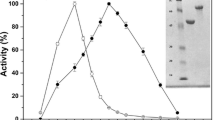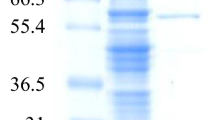Abstract
The catalytic activity of β-galactosidases from fungi Penicillium canescens and Aspergillus oryzae is maximum in a weakly acidic medium and does not depend on the presence of magnesium cations in the reaction medium. The enzyme from Aspergillus oryzae fungi is more active, and that from Penicillium canescens is stabler. One of stability indications is the presence of an induction period in the kinetic curves of thermal inactivation. This period disappears at 54°C for the enzyme from Aspergillus oryzae and at 59°C for the enzyme from Penicillium canescens. The temperature dependences of the effective rate constants for the inactivation of the tetrameric enzyme from Penicillium canescens show that the main reason for enzyme inactivation is the dissociation of oligomeric forms below 66°C (E act = 85 kJ/mol) and enzyme denaturation at higher temperatures (E act = 480 kJ/mol). The dissociation stage is absent for monomeric β-galactosidase from Aspergillus oryzae fungi, and the activation energy of inactivation is 450 kJ/mol over the whole temperature range studied (53–60°C).
Similar content being viewed by others
References
N. Albayrak and St. Yang, Biotechnol. Bioeng. 77(1), 8 (2002).
R. Gaur, H. Pant, R. Jain, and S. R. Khare, Food Chem. 97(3), 426 (2006).
W. Bednarski and A. Kulikowska, Chem. Pap. 61(5), 364 (2007).
Y.-J. Lee, C. S. Kim, and D. K. Oh, Appl. Microbiol. Biotechnol. 64, 787 (2004).
Y.-S. Kim, C.-S. Park, and D.-K. Oh, Enzyme Microb. Technol. 39(4), 903 (2006).
I. V. Nikolaev, O. V. Bekker, V. A. Serebryan, and Yu. P. Vinetskii, Biotekhnol. 3, 3 (1999).
M. Machida, K. Asai, M. Sano, et al., Nature (London) 438, 1157 (2005).
Y. Tanaka, A. Kagamiishi, A. Kiuchi, and T. Horiushi, J. Biochem. 77, 241 (1975).
A. A. Shishkin, O. M. Poltorak, E. S. Chukhrai, et al., Zh. Fiz. Khim. 64(8), 2169 (1990).
L. F. Atyaksheva, O. S. Pilipenko, O. M. Poltorak, and E. S. Chukhrai, Zh. Fiz. Khim. 81(7), 1313 (2007) [Russ. J. Phys. Chem. A 81 (7), 1156 (2007)].
O. S. Pilipenko, L. F. Atyaksheva, O. M. Poltorak, and E. S. Chukhrai, Zh. Fiz. Khim. 81(6), 1130 (2007) [Russ. J. Phys. Chem. A 81 (6), 990 (2007)].
O. M. Poltorak and E. S. Chukhrai, Itogi Nauki Tekhn., Ser. Biotekhnologiya 5, 50 (1987).
A. E. Lyubarev and B. I. Kurganov, Usp. Biol. Khim. 40, 43 (2000).
S. Yoshioka, Y. Aso, K. Izutsu, and S. Kojima, Pharm. Res. 11(12), 172 (1994).
G. I. Makhatadze and P. L. Privalov, Adv. Protein Chem. 47, 307 (1995).
Author information
Authors and Affiliations
Corresponding author
Rights and permissions
About this article
Cite this article
Pilipenko, O.S., Atyaksheva, L.F., Poltorak, O.M. et al. The catalytic properties and stability of β-galactosidases from fungi. Russ. J. Phys. Chem. 82, 2250–2254 (2008). https://doi.org/10.1134/S0036024408130165
Received:
Published:
Issue Date:
DOI: https://doi.org/10.1134/S0036024408130165




